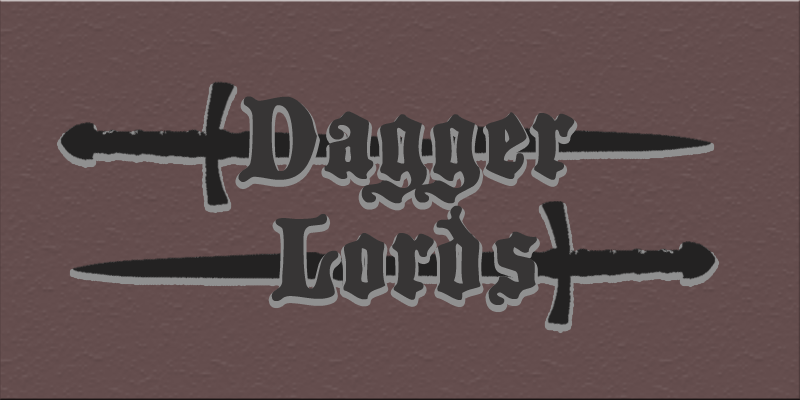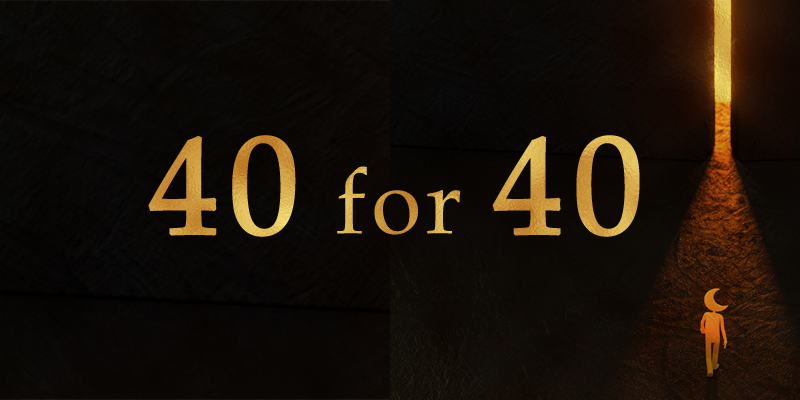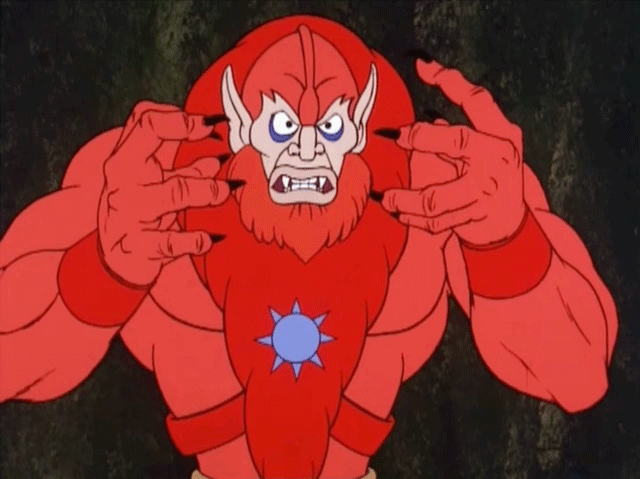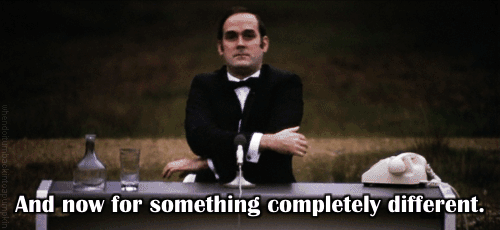It’s Mini Monday, where we share miniature projects for your roleplaying and tabletop gaming. This week we’re drawing our daggers and charging into combat!  Blades out, everyone! Dagger Lords is a skirmish game, so expect lots of stabby stabbing.
Blades out, everyone! Dagger Lords is a skirmish game, so expect lots of stabby stabbing.
Episode 1: Concept and Theme
Episode 2: Initiative and Turns
Episode 3: Movement
Episode 4: Combat
Episode 5: Powers and Playtesting
Episode 6: Polishing the Game
We’re updating the public Dagger Lords game document as we go, so be sure to check in and see what we have so far. Don’t forget to leave a comment too, because it gets lonely here in the looney bin.

Sexy Simple Systems
Movement, activation, and combat are all systems. Many games that fall into the tabletop gaming hobby are made up of many different systems, often built around a core mechanic such as rolling dice or drawing cards. Dungeons & Dragons and Pathfinder use the core mechanic of rolling a d20 and adding modifiers to it. Combat, skills, and saves — all separate systems — all use this core mechanic.
As a game designer, you have to balance the number of systems well and reuse the core mechanic wherever you can, otherwise you risk creating a system that’s too complicated. Reusing systems is a great way to keep a game manageable, even as it grows. For example, if my combat system and my magic system are essentially the same, I can spend less time explaining it in the rules and players can jump into those rules with less cognitive effort.
This, by the way, is one reason why I hate objective cards in Warhammer 40,000. Give me a table and make me roll for it, please. And don’t ask me to roll dice in Magic: the Gathering.
Of course, each system covers a different aspect of the game and needs to be tailored to those specific needs. Our goal is to keep things as simple as we possibly can. This is the essence of all design: to find the simplest, most elegant solution to a given problem.
We’re covering hand-to-hand combat today, but you could extend these rules to cover shooting, magic, and other systems, with a little work.
Dice
Choosing which dice to use has a big effect on our game’s mechanics. Die sizes impact the roll ranges, probability of a result, average rolls, and the totals we can expect from a die. For example, rolling 2d6 will give us a result of 7 much more often than a result of 12, while a roll of 1d12 has an equal chance of giving us a 6 or 12. Dice and dice probability is a huge topic that’s worth understanding, so do your own research if you’re serious about game design. We’ll just cover some basics needed for our own game of Dagger Lords.
Certain dice map neatly to percentages. A d10 gives you a range from 10%–100%, in tens. A d20 gives you a range from 5%–100%, going up in fives. Put another way, you have a 5% chance of rolling a nat 20 on a single d20. This gives us a useful benchmark. If we know that most champion boxers land 20% of their punches, then we can map this directly to the dice: hitting requires a 9 or more on a d10 (the probability of getting a 9 or 10 is 20%).
We’ve already got our Reflex Point mechanic and our initiative system, the latter of which includes rolling dice. Previous versions of that system used 2d6 for initiative rolls. Let’s change to ten-sided dice, across the game. This is an important decision because a game is a sum of its parts; the better those parts sync, the better the game will play.

Developing Hand-to-Hand Combat Rules
Let’s break down combat into its component parts.
Core Mechanic
I do like my d20 systems, it’s true, probably because I spend a lot of time developing rules for d20 games. Stealing from what you know is a good way to start out, so let’s steal from D&D. We can always modify things as we get further into development.
Our core mechanic, then, might look something like this:
Roll = 1d10 + Ability Score + Modifies – Penalties
Abilities
We’ll need to decide on abilities next then. We could simply have a Brawl ability that works for attack and defence. We might want a more complicated system including Brawl, Dodge, Strength, Damage, Armor Penetration, Armor, and so on. Some of these will be tied to weapons, but they still describe the abilities of a single model.
Think of it as a continuum, from super simple on one side to extremely complex on the other. We need to find the best balance of complexity for the game we’re making. Part of this is about knowing your audience and the level of complexity that’s right for them. For a skirmish game, we might choose a level of granularity that’s more complex than a large wargame, which has hundreds of miniatures, and less complex than an RPG, which has a single character per player. If our players are teens, we can ramp up the complexity, while very young players might only handle three abilities, at most.
Tying things back to Reflex Points, we could have the following abilities:
- Reflex: Determines your reaction speed and ability to dodge. Your starting Reflex Points are based off this ability. Reflex is 2 for our prototype.
- Brawl: Your ability to fight in hand-to-hand combat, both with and without weapons. We’ll set this to +2 for now.
- HP: How much damage you can take before you die.
Attacking
To make an attack against an enemy model within 2 inches of your model, you roll 1D10 and add your Brawl modifier. The target rolls 1D10 and adds their Reflex modifier. You can each spend a Reflex Point before you roll to add +2 to the total roll. If you equal or beat the target’s score, you have scored a hit. The target loses 2 HP.
Dagger Lords — Prototype Game: Daggers Out
The objective of this game is to knock your opponent off a pillar. Neither you nor your opponent can move, all you can do is stab at them in an effort to knock them off their perch before they get you off yours.
Setup and Rounds
Each player controls 1 gangster miniature, with the player representing the gang boss. A game has two players. Any miniatures can be used, and for these rules, only close combat weapons are considered because of powerful magic influencing the battlefield. Each mini has 2 Reflex Points, 2 Reflex, +2 Brawl, and 3 Hit Points.
The game is played in a number of rounds, and each round has three phases:
- Initiative
- Activation (Combat)
- Top-Up
1. Initiative
Each player rolls 1d10 for their gang. Each miniature can spend 1 of their 2 Reflex Points to add +2 to the roll. Play proceeds in order from the player with the highest total to the player with the lowest total.
Dice off for ties.
2. Activation
Each player then acts in initiative order and can activate their miniature. At the start of the player’s activation, their model gains a number of Reflex Points equal to the following equation:
Activation Reflex Points = (Remaining Reflex Points x 2) – 1
The minimum number of Activation Reflex Points a model gains is always 1.
To activate a miniature, you must spend a Reflex Point to make an attack.
To make an attack against an enemy model on the next pillar, you roll 1D10 and add your Brawl modifier. The target rolls 1D10 and adds their Reflex modifier. You can each spend a Reflex Point before you roll to add +2 to the total roll. If you equal or beat the target’s score, you have scored a hit. The target loses 2 HP.
Any model can interrupt another model’s attack to attack instead by spending 1 Reflex Point. The order is decided in the order of declared interrupts, so it’s possible for a model to interrupt another model that is interrupting it, the player only has to declare their interrupt after the interrupting player does, and spend the required Reflex Points to do so.
3. Top Up
After all the models have activated, each model that isn’t destroyed regains 1 Hit Point and up to 2 Reflex Points. A model can never have more than their starting amount of these points.
Winning and Losing
The first gang member to lose all 3 Hit Points falls off their pillar, and their opponent is the winner.
40 for 40 Sale
I turned the big Four Oh this month, and to celebrate we’re running a bunch of sales all month long.
 On our store, you can use the coupon code “40for40” to get 40% off your cart’s total value at checkout. You can use the coupon as many times as you like, until the end of the month.
On our store, you can use the coupon code “40for40” to get 40% off your cart’s total value at checkout. You can use the coupon as many times as you like, until the end of the month.
Many of our products are 40%-off on Drive Thru RPG. This includes many titles for fifth edition fantasy, the Pathfinder Roleplaying Game, and stand-alone titles. We also have a few Pathfinder Second Edition and Starfinder Roleplaying Game titles.
On the DMs Guild we’ve got a massive bundle worth over $60 going for less than $16. This bundle includes many of our best-selling titles, so if you’ve bought them already you’ll pay even less to fill out your collection.
Hi there, I’m Rodney.
Writer, Game Designer, Editor, Kitbasher, Skateboarder, and Ork ‘Ed Banga. But Nothing Without Christ!
































